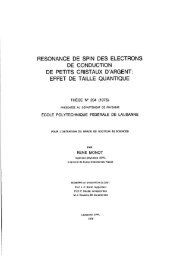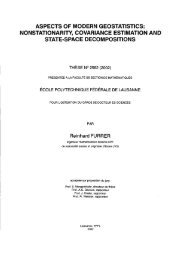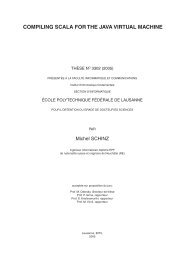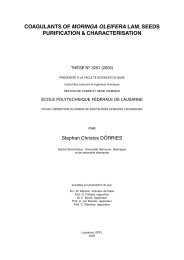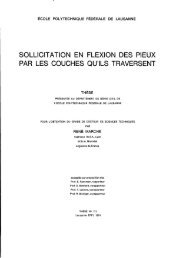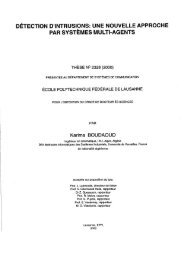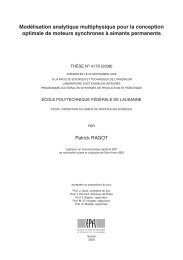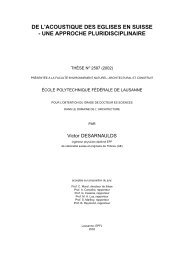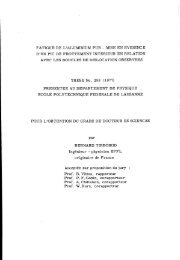improving safety and productivity of isothermal semi-batch ... - EPFL
improving safety and productivity of isothermal semi-batch ... - EPFL
improving safety and productivity of isothermal semi-batch ... - EPFL
You also want an ePaper? Increase the reach of your titles
YUMPU automatically turns print PDFs into web optimized ePapers that Google loves.
IMPROVING SAFETY AND PRODUCTIVITY<br />
OF ISOTHERMAL SEMI-BATCH REACTORS<br />
BY MODULATING THE FEED RATE<br />
PAR<br />
Olivier UBRICH<br />
lngdnieur chimiste ENSSPICAM<br />
de nationalit6 franqaise<br />
acceptbe sur proposition du jury:<br />
Pr<strong>of</strong>. F. Stoessel, directeur de thhe<br />
Pr<strong>of</strong>. D. Bonvin, rapporteur<br />
Pr<strong>of</strong>. K. Hungerbijhler, rapporteur<br />
Pr<strong>of</strong>. G. Kille, rapporteur<br />
Dr Th. Meyer, rapporteur<br />
Lausanne, <strong>EPFL</strong><br />
2000
Version abregee<br />
Depuis la prise tle conscience cies risques que penvent erltrairrer urle production<br />
cllimique ma1 gkrke, dc nornbrcuscs cntrcprises sc sont penchkes sur la si.curit6 thcrmiquc<br />
dcs procCd6s. Ces dernihrcs annkcs, le contrale des r6actions cst devcnn nn<br />
dcs soucis ~najcrlrs dcs indr~strics. Afin d'avoir un mcillc~~r contrblc, Ics proc6diis dc<br />
chimie fiue sent la plupart du temps rBalisCs en mode serni-<strong>batch</strong>. De nlClnle, pour des<br />
raisoms de selectivit6, Ic mode isothcrmc cst souvcnt Ic lr~ode utilise. Ainsi, normalt:ment,<br />
les reactions se dCroulent sans incidents. Cependant, occasior~nellement, elles<br />
s'ernballent parce que des materiaux inadecluats out kt6 utilisb, parce que les conditions<br />
operatoires ont chaugCt 011 encore parce qne les Cqnipemer~ts sont d6fect11e1~u.<br />
Lors dc toutc 6tudc dc scaleup, dc~uc questions fondamentalcs doivent Btrc posbcs. La<br />
prcmihrc cst relative aux conditions normalcs dc fonctio~nicmcnt. I1 cst n6ccssaire dc<br />
v6rificr que le systhmc dc refroidisscmcnt soit capablc dc maintcnir la tempkraturc sltr<br />
la trajectoire dksirke. Pour cela, il faut vBrifier sorl aptitude ii Bvacuer ii tout instant<br />
la cl~aleur produitc par la rkaction chirnique. Ainsi, lc systkme est capable de rester<br />
en mode isotherme. La deuxikrne est relative ii I'Bvolution de la nlasse r6actionnelle<br />
en cas de dysfonctionnernent. I1 est r~kcessaire de vkrifier que la rBactio11 ne puisse<br />
p~s cor~duire ti une situatior~ critiqne en cas de parlne ~ Isysterr~e I tle refroidissetnent.<br />
Avant tolitc mise cn production d'un nouvcan procbd6 scmi <strong>batch</strong>, tmc 6t1ldc<br />
dc s6curitB est rkaliske. La plupart du temps, clle sc bornc h vkrificr In faisabiliti: du<br />
prockdi! pour un flu d'introductior~ de reactif cot~sti~t~t. Ut1 tel flux est utilise pour<br />
des raisons pratiqucs: il cst cn cffct Ic 11l1ts fitc.ilt9 .:I ri-i~list.~.. II c~sistc~ elor~c c.11 cc poi~~t<br />
precis n~atiere ii am6lioratior1 tiit lit ~)~.t~cI~~c~ti\~ili.. I
sance cfcs contraintcs A chaque instant pcrn~ct de d6finir uric fonction d'introduction<br />
optimale. I1 cst alors possi1)le de ddtcrminer explicitenlent nnc fonction d'ajont compos6c<br />
de diffkrcntes scgmcnts kvcntucllcnlcnt approchks par unc succcssion dc diffbrcnts<br />
palicrs. Dc mgmc, lcs temp dc basculcment entre ces diffhrcntes scgmcnts<br />
sont connus. En fait, il existe deux rnani6res de r6aliser l'implaritation de la m6thode:<br />
soit en boucle fermke, soit en boucle ouverte.<br />
La m6thode va 6tre app1iqui.e datis un premier temps en boucle ouverte. Dar~s<br />
cc cas il est ndccssairc de trouver dc facon cxplicite la cinetiquc de la reaction 6tudiCe<br />
avant de po~~voir rdaliscr l'optiniisation. Cctte btude cir16tique B 6tk r6alisi.c cn couplant<br />
la calorinlbtrie ct la spcctroscopie (infrarougc ct Raman) lors de m6mes expbricnces.<br />
Une fois la cinetique Ctablie, l'optimisation est test6e expbrimentalement:<br />
les rdst~ltats sont compards avcc dm sin~i~lations thCoriques. La nlkthodc s'av&rc efficace,<br />
rriais est trh dkpendante de la precision de I'etude cinktique. De plus, elle peut<br />
s'avkrer probl6rriatiyue lors de son implantation si la cinktique ne corresporid pas li<br />
celle deterrninee en laboratoire.<br />
Dc cc fait, la mbthodc d'optimisation utilisant une boilclc ferm6c revet des avantages<br />
ddtermiriants. Afin de pouvoir implanter la mbthode en boucle fcrrnbc, il a 6t6<br />
necessairc dc modifier un calorinlbtre commercial dc maniere a determiner l'dcart de<br />
la trajcctoirc par rapport a la contrainte active et de l'y maintcnir. L'installation<br />
a bt6 utiliske pour optimiser une r6action aux parametres cin6tiqucs inconnils. Elle<br />
permettra kgalement de prouver l'importance de I'utilisation de boucles fernlees en<br />
se niontrant trks robuste vis a vis de l'utilisation de produits plus ou moins purs.<br />
Ainsi, ce travail met en kvidence l'importance de l'utilisation d'une fonction<br />
ti'ajout non 1int.aii-e pour des procdes <strong>semi</strong> <strong>batch</strong> r6alisi.s en mode isotherme. Elle<br />
pcrrnct uric arnklioration de la productivitk tont en 6vitant les risques thcrrniques<br />
en conditions normales de fonctionnement, conime en cas de panne du systen~e de<br />
refroidissemcnt.
Summary<br />
In recent decades, a more pr<strong>of</strong>ound underst<strong>and</strong>ing has been realized that 1111controlled<br />
chemical processes can lead to accidents with severe conscqnences. Many<br />
chemical corripanies became active in research on thermal risks. For chemical engineers,<br />
the control <strong>of</strong> chenlical reactions becarrie one <strong>of</strong> the most important concerns.<br />
Thus, for a better control, most fine chemical processes today are performed in a<br />
<strong>semi</strong>-<strong>batch</strong> mode. Also, <strong>isothermal</strong> operating conditions arc <strong>of</strong>ten employcd for inlproved<br />
sclcctivity. As a rule, the chcrr~ical reactions proceed without problems, 1~1t<br />
in some rare cases unfortunately a runaway situation is encolintered, because wrong<br />
mat,crial havc been uscd, opcrating conditions havc changed, or cquipmcnt has been<br />
deficient.<br />
In any scale-up from laboratory or pilot to full-scale operation, two cluestions must<br />
be answered. The first one relates to the normal operating conditions. Indeed, it will<br />
always be necessary to verify that the reactor temperature can be niaintained along<br />
the dcsircd path. In other words, it mnst be verified that the capacity <strong>of</strong> the cooling<br />
system will at all ti~nes be able to ncntralizc cxccss heat gcr~cratctl ar~ywhcrc within<br />
the rcactor by the chcrnical reaction. The system will thcn function isothcrn~ally.<br />
The second cllicstion relates to the bchavior <strong>of</strong> rcactor tcmpcratnre in thc c=c <strong>of</strong><br />
technical failures. It will bc ncccssary to verify, for instancc, that a critical situation<br />
can be avoided when the cooling breaks down.<br />
Thermal studies are realized, therefore, before any new <strong>semi</strong>-<strong>batch</strong> process is put in<br />
operation. With respect to reaction cornponent feed, such studies gerierdly tent1 to<br />
cvalnatc the fcasibilit,~ <strong>of</strong> the process under coiidit,ior~s <strong>of</strong> a st,rict,ly linear ii~t,rod~iction<br />
<strong>of</strong> one componcr~t into the reacting system. Such a fed function is uscd for practical<br />
rcasons like case <strong>of</strong> implcmcntation. Howcvcr, no fnndamcntd rcasons spcak against<br />
using a nonlinear fccd function. Lifting thc limitation to lincas fccd frlnctions may<br />
actnally opcn up ways to improvc the <strong>productivity</strong>. Physical <strong>and</strong> <strong>safety</strong> constrain1,s<br />
rnust <strong>of</strong> course be respected just as rigorously when using a nonlinear feed function.<br />
It was the airn <strong>of</strong> this work to define a method that can be applied to run isotherrn:il<br />
<strong>semi</strong>-<strong>batch</strong> reactors while using a controlled nonlinear feed rate. This method should<br />
yield scnsit)ly reduced cyclc timcs while fiilly acco~~~rr~odating all irnposctl coristraints.<br />
Thc n~odnlation <strong>of</strong> fccd rate rnust be such that thcsc objjectives can 1)c achieved.<br />
Toward this aim, a preliminary mathematical study <strong>of</strong> nonlinear systems ha< first<br />
1)cen realized. A simple mcthod is presented in this part <strong>of</strong> the work which allours
one to recognize whether a given chernical reaction model will be influenced by the<br />
feed <strong>of</strong> one <strong>of</strong> the components. In systems defined a? being "feedback linearizable",<br />
the production optimum depends on the constraints alone. This means that the optimlmm<br />
feed rate can be defined fiom a mere knowledge <strong>of</strong> the dominating constraint as<br />
a function <strong>of</strong> time. It will then be possible to explicitly deterrniue the function as a<br />
composite <strong>of</strong> different consecutive segments, each depencling on an active constraint.<br />
The switching times Getweer1 the different segn~erlts can also be defined. Implementation<br />
may occur in ;in opo~ or in n closccl loop.<br />
In a first np~)ro;lc:l~. lilt: IIII~I~IIII~ \\.;is ~~li~I~orii~(~l li~r o1)(:11-1001) S~S~CIIIS. As a prercq~~isilc<br />
to ol)ti~r~iz;~~io~~.<br />
t111a. IIIII>I ~.s~~Ii~.itl\ II~-II,~III~II(! 11~: kinet;ics <strong>of</strong> the chemical<br />
sys11~111 (,ol~siIit~rI~l. *r11i> \\;L\ I ~ ~ I I ill I ~ . t11t. ~II..I;IIII.I, t)f' it i~~~~)r(!scl~t.;lti~~c reaction, by<br />
o i I r i ~ I ~ ~ r t t t i ( it t i ' i ~ I l I I I ) ~csren~ents. Usil~g<br />
tllc, ki~~c-tia. I)~II.~IIII~~II.I~ tIt.11'1 111i11tll1 ill IIIIW. IIII~~I~II~I~IIIL'II~S, the optirrlization was<br />
~xrSvr~~~erl. 'I'II(w (.~l)I:ri~l~ta~~l . l1i14 1.4 WIII 11i1vc I,~~.II cor~~pared with theoretical<br />
si~~ruli~tio~is. T~II* IIII~I~IIII~ I)~II\IYI III \)I. t~liic:iciit, I~ut also strongly cfepenclent on the<br />
accnracy <strong>of</strong> thc ki~ict.ic. cl;lt;l. Tlicrclbrc, apart from below-optinl~nn process conditions,<br />
hazartloi~s sitliatio~~s I I I IJ)C ~ ~ CIICOIIII~~~C~, for instance, as a result, <strong>of</strong> changes<br />
in reaction kinetics caused by conta~nination <strong>of</strong> the reaction medium. Hcrc an 011line<br />
optimization implementing a closed-loop optimization algorithm presents strong<br />
advantagw.<br />
For the work involving closed systerns, it was necessary to use a rnodified reaction<br />
calori~r~eter allowing the trajectory divergence to be evaluated relative to the active<br />
constrai~lt, <strong>and</strong> coutrol the systerr~ accordingly. This i~~stallation was utilized for the<br />
optinlizatio~~ <strong>of</strong> a chenlical reaction for which the kinetic parameters were unknown.<br />
The si~periority <strong>of</strong> thc closed loop was also demonstrated by revealing its robustness<br />
with regard to a contamination <strong>of</strong> the reaction system by an impurity affecting the<br />
kinetics.<br />
In conclusion, it was shown in this work that 1~y using a modulated rextant feed<br />
function for serni-<strong>batch</strong> processes performed <strong>isothermal</strong>ly under constraints one can<br />
sigr~ificantly improve the <strong>productivity</strong>, <strong>and</strong> at the same time avoid severe consequences<br />
<strong>of</strong> incidences such a? a cooling failure.
Contents<br />
Nomenclature<br />
1 Introduction<br />
2 Bibliography<br />
2.1 Iritroduction ................................<br />
2.2 Thcr~nal stability .............................<br />
2.2.1 In 11or111al operating .......................<br />
2.2.2 Coolir~g failure ..........................<br />
2.3 Optirnizatiom <strong>of</strong> thc proccss .......................<br />
2.3.1 Optimization without any constraints ..............<br />
2.3.2 Optimization under constraints .................<br />
2.4 Organii~at~ion <strong>of</strong> thc thcsis ........................<br />
3 Characterization <strong>of</strong> the optimal solution<br />
3.1 Introduction ................................<br />
3.2 Preliminaries ...............................<br />
3.2.1 Nonlinear systems . ........................<br />
3.2.2 Short introduction to Lie algebra ................<br />
3.2.3 Feedback linearization ......................<br />
3.3 Forrr~ulatiorl <strong>of</strong> the optimization problern ................<br />
3.3.1 Problern forniulation .......................<br />
3.3.2 Optirnurn <strong>of</strong> a feedback linearizable system ...........<br />
3.3.3 Singular regions . .........................<br />
3.3.4 Characterization <strong>of</strong> optimal input for feedback linearizable systerns<br />
................................<br />
3.3.5 Formulation <strong>of</strong> constraillts ....................<br />
3.3.6 Shapc <strong>of</strong> thc optimal solution ..................<br />
3.4 Proposcd methodology for finding an optimal solutior~ .........<br />
3.5 Kinetic models in isothcrmal mode ...................<br />
3.5.1 Case <strong>of</strong> consecutivc reactions ...................<br />
3.5.2 Case <strong>of</strong> diffcrcnt ordcr parallel reactions ............
CONTENTS<br />
3.5.3 Case <strong>of</strong> same order parallel reactions .............. 55<br />
3.5.4 Case <strong>of</strong> nth-order reactions with impurity in feed ........ 56<br />
3.5.5 Case <strong>of</strong> consecutive parallel reactions, case number one .... 58<br />
3.5.6 Case <strong>of</strong> consecl~tive parallel reactions. casc number two .... 60<br />
3.5.7 Case <strong>of</strong> nth-order reactions with decomposition . ........ 63<br />
3.5.8 Recapitulation ........................... 64<br />
3.6 Qualitative comparison wit11 the method used in industry ....... 67<br />
3.7 Conclusions ................................ 69<br />
4 Off-line feed control: Case study<br />
4.1 Int~oductior~ ................................<br />
4.2 The reaction ................................<br />
4.2.1 The model reaction examined ..................<br />
4.2.2 Plailsibility check for the reaction being 2nd order .......<br />
4.2.3 Can the selected reaction be considered as a 2nd order reaction?<br />
4.3 Identificatiorl <strong>of</strong> kinetic pararrieters ...................<br />
4.3.1 Results <strong>of</strong> thc spectroscopic measurements ...........<br />
4.3.2 Results obtained by calorimetry .................<br />
4.3.3 Evaluation <strong>of</strong> the activation energy <strong>and</strong> <strong>of</strong> the frequency factor<br />
4.3.4 Calorimetry or spectroscopy: advantages/disadvantages . ...<br />
4.4 Optimization: experinlerital results ...................<br />
4.4.1 Spectroscopic results .......................<br />
4.4.2 Calorimetric results ........................<br />
4.5 Optimum constar~t feed rate: experirnerltal results ...........<br />
4.6 Comparisons ................................<br />
4.7 Conclusion<br />
.................................<br />
5 On-line feed control: Case studies 97<br />
5.1 Introduction ................................ 97<br />
5.2 Experirnentalset-up ........................... 98<br />
5.3 The second-order reaction: experirncntal results ............ 101<br />
5.3.1 Calibration ............................ 101<br />
5.3.2 On-line results . .......................... 102<br />
5.3.3 Cornparkon with constant feed rate . .............. 104<br />
5.3.4 Limitation <strong>of</strong> the method . .................... 105<br />
5.4 A more complex reaction system: experimental rcsillts ........ 105<br />
5.4.1 The reaction . ........................... 106<br />
5.4.2 Heat <strong>of</strong> mixirlg .......................... 107<br />
5.4.3 Heat <strong>of</strong> rcaction .......................... 108<br />
5.4.4 h/lodulated feed method with pure product: experimental results109<br />
5.4.5 Parametric sensitivity ...................... 114<br />
5.4.6 Adiabatic experiments ...................... 116
CONTENTS 13<br />
5.4.7 Cornparison with constant feed ratc ............... 118<br />
5.5 Modulated feed mcthod with impure product ............. 119<br />
5.5.1 Constant feed rate expcrimc~lt .................. 120<br />
5.5.2 Modrilated fced mcthod: cxpcrimental results ......... 120<br />
5.5.3 Cornparisor1 ............................ 121<br />
5.6 Conclusiori ................................. 122<br />
6 Conclusions 125<br />
6.1 Summary ................................. 125<br />
6.2 Perspect;ives ................................ 127<br />
7 References 129<br />
8 Annex 137



